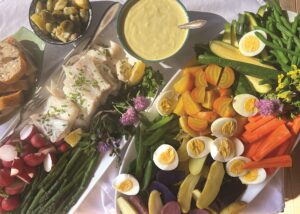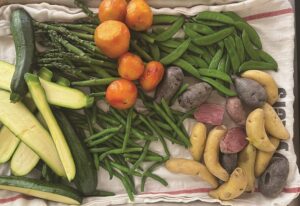It was Wa’reen who taught me how to make aioli. A taciturn African-American woman from New Orleans’s historically Creole 7th Ward, Wa’reen was the cook who ran the hors d’oeuvres station at the fancy catering company where I worked during my college years.
At Panache! the exclamation point was very much part of the name, and the menus tended toward 1980s excess. There were butter-and-cream-rich dishes like chicken Kiev, which apparently is unknown in Ukraine; smoked salmon rillettes on toast points; vol-au-vent shells filled with creamy whatever; and blackened everything.
The preparation of any of those dishes was well above my pay grade. But under Wa’reen’s reluctant tutelage, I was allowed to put together simpler things, including the veggie plate. That’s what we called it in the back of the house, as in, “Two veggie plates for the Boudreaux luncheon!”

On the menu it was called Creole Aioli. It was a shimmering bowl of fresh-made garlic mayonnaise surrounded by perfectly boiled and blanched baby vegetables, and it was gorgeous, although I’m not sure what exactly made it Creole. Maybe it was the shrimp: Gulf shrimp were delivered still jumping to the kitchen’s back door, poached, and added to the platters. Other times the shrimp were replaced by thick chunks of the best tinned Italian tuna.
I became adept at blanching the vegetables, composing the platters, and making the sauce — adding the salad oil drop by precious drop until the aioli emulsified.
Those veggie plates came to mind last week when Christopher scored two bottles of the new sparkling cuvée blanc from Truro Vineyards and declared it was time to ease our way into summer socializing by inviting a few friends over for a drink on the porch. We would need something more than Cheez-Its to go with the wine.
Before deciding what to make, I rifled through my battered Redwell stuffed with recipes torn from newspapers and magazines. There, on a page ripped out of the New York Times, was Gabrielle Hamilton, she of Prune in the East Village (a place, it seems, that’s now of blessed memory), writing about le grand aioli.
I love Hamilton’s writing so much. She can turn a carrot into a poem, on the plate or on the page. Her column was a love song to simple summer gatherings, the kind with mismatched plates and glasses and plenty of room for whoever is around.
The recipe has a number of steps, but it’s mostly about boiling vegetables until they’re just done. To do this properly, Hamilton advises salting the water more aggressively than you would for pasta. When you taste it, she says, “the water should make you pucker.”

Rather than shock the vegetables in cold water, Hamilton allows them to cool on a baking sheet lined with a dish towel, the residual heat finishing the cooking. I followed her instructions — though this is not how we did things at Panache! — and the dish was very good.
Hamilton wants you to prepare all the vegetables and the sauce the day you intend to serve them. I think we could be forgiven for preparing the vegetables a day ahead. I agree, however, that the aioli is best made day-of.
With regard to the seafood, Hamilton has an East Coast sensibility. Her grand aioli calls for steamed cod and mussels quickly sautéed with shallots, thyme, and wine. Not finding good mussels at my local fishmonger, I made ours with cod alone.
As with the Creole version I learned from Wa’reen, Hamilton’s dish is organized around the sauce. Beyond that, she says, “its components are loosely governed.” This time, I included sugar snap peas and asparagus because they’re in season now and carrots for color and because I had them. The mix will surely change as summer goes on.
Though each step is easy, it did take me a couple of hours to cook and cool all the vegetables. The aioli and the fish are quick. Remembering all I had learned from Wa’reen, I arranged it all on the biggest platter I have and opened the wine — with panache.
Cape Cod Aioli
Makes 6 generous servings
For the platter:
1½ lbs. thick cod fillets, skin removed, cut into 6 equal pieces
Kosher salt
1 lb. baby beets, trimmed and scrubbed
Extra-virgin olive oil
Fresh-ground black pepper
2 Tbsp. red wine vinegar
14-16 new or fingerling potatoes, scrubbed
½ lb. green beans, stem end trimmed
½ lb. yellow wax beans, stem end trimmed
1 pound small zucchini
3 carrots
6 eggs
1 bunch French breakfast radishes, well rinsed, large leaves trimmed
2 pounds mussels
1 clove garlic, slivered
1 shallot, chopped
3 sprigs thyme
Pinch of red chili flakes
½ cup white wine
For the aioli:
3 cloves garlic, grated on a microplane
1 large egg at room temperature
1 large egg yolk at room temperature
Juice of 1 lemon, plus more to taste
1 Tbsp. water
Kosher salt
1 cup neutral oil (such as canola or grapeseed)
½ cup extra virgin olive oil
- The night before you plan to serve the aioli, season the cod with kosher salt on both sides; cover and refrigerate overnight.
- Preheat oven to 400° F. Place beets in a small roasting pan, coat them with 4 tablespoons of olive oil, and season with salt and pepper to taste. Add the red wine vinegar and 4 tablespoons water to the pan. Cover with foil and roast until beets are tender, approximately 1 hour. Check beets halfway through cooking and add more olive oil and water if the roasting pan looks dry. When just done, remove beets from oven and uncover the pan. Cover the beets with a clean kitchen towel and let them stand until cool enough to handle. Using the kitchen towel (or paper towels) to help you, rub off the outer skin of the beets. Peeling the beets while they are still warm makes the otherwise difficult task easy. Set aside the peeled beets until completely cool, then halve or quarter them.
- While the beets are cooking, fill a large pot with water and bring it to a boil. Season aggressively with salt, “enough to make you pucker,” says Gabrielle Hamilton.
- Lower the heat so that the water is at an energetic simmer. Add the potatoes and cook them until they’re easily pierced with a paring knife, about 12 minutes. Remove from the simmering water with a slotted spoon and transfer to a sheet tray lined with a clean kitchen towel to cool.
- Add the green beans and wax beans to the simmering water and cook until tender, 4 to 5 minutes. Remove using a slotted spoon and transfer to the sheet tray to cool.
- Add the whole zucchini to the simmering water and cook until just tender, about 5 minutes. Remove with slotted spoon and transfer to the sheet tray to cool. Do the same with the carrots.
- Turn the heat up on the pot of water, returning it to an aggressive boil. Gently lower the eggs into the boiling water using a slotted spoon, being careful not to crack their shells. Simmer 10 minutes and remove the eggs from the water. Peel them quickly under cool running tap water. Cut them in half lengthwise.
- Once the vegetables are cool, slice the potatoes in half. If the zucchini are very small, you can leave them whole; otherwise halve or quarter them lengthwise.
- Halve or quarter the radishes.
- Place cod in a steamer basket in a large pot over a half inch of simmering water. Cover and steam gently until just cooked through, about 5 minutes. Remove fish from the steamer and set aside to cool.
- Make the aioli, placing the garlic, the whole egg and the extra yolk, the lemon juice, the water, and a generous pinch of kosher salt in a food processor. With the processor running, slowly drizzle in the oil. The aioli will start to thicken and emulsify after a few minutes. If the aioli is too thick, add another tablespoon of water to loosen. Taste the aioli and adjust for seasoning, adding more salt, lemon juice, or microplaned garlic as needed.
- Arrange fish and vegetables on platters with a generous bowl of aioli alongside. Set out small plates for guests to serve themselves and spoons for slathering on the aioli.



